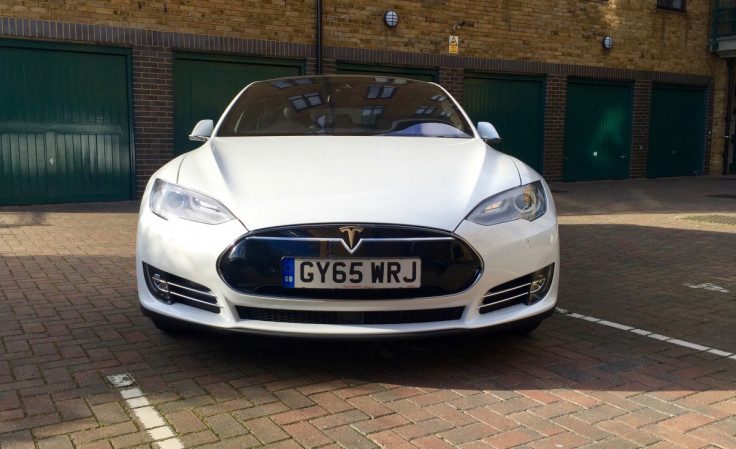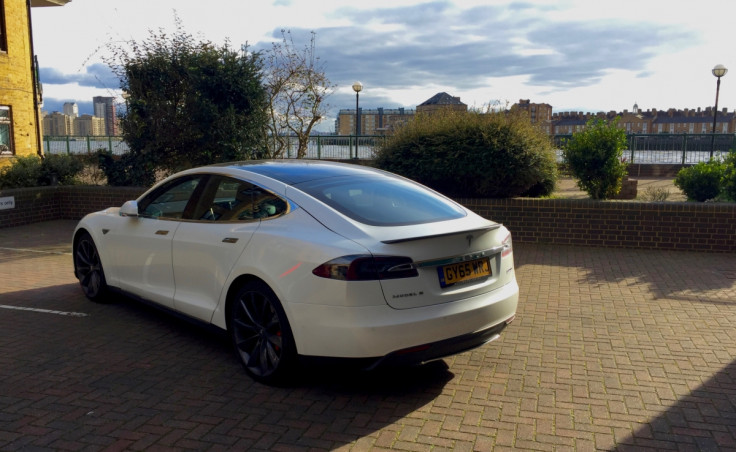Tesla Model S P90D review: Car-next-door looks hide rocket ship performance
We drive the Tesla Model S P90D with 'Ludicrous speed' mode.

There is no way to start a review of the Tesla Model S P90D without getting straight to the car's party trick. In standard form, this all-electric car can accelerate from zero to 60mph in 3.2 seconds, but the £8,700 'Ludicrous Speed' option fitted to our review cars sees this drop to 2.8 seconds.
Tesla Model S P90D specs:
- Priced from £87,300 (Ludicrous Speed Upgrade adds £8,700)
- 90kW battery pack
- 762 horsepower split 503 rear / 259 front
- 0-60mph in 2.8 seconds
- Top speed: 155mph
- Range: 315 miles (claimed)
- Charge time: Around one hour at Tesla Supercharger
A 2.2-tonne, five-seater family car hitting 60 in 2.8 seconds is utterly absurd. It feels like a rollercoaster and is made even more surreal by the complete lack of noise. You are pinned into your seat as the blood drains from your face and the seatbelt clamps you in place.
Then, just as your brain is expecting - yearning, demanding - the momentary relief of a gear change, the Tesla continues to surge onward. It has just one forward gear, making the accelerative onslaught truly relentless until the points on your licence are increasing as quickly as the speedometer.
It's a genuinely exhilarating experience which is as addictive as it is impressive. Passengers reactions are priceless, as you can see here thanks to a quick (and swear-filled) compilation I recorded.

So that's Ludicrous mode, the party trick which feels like Elon Musk has jailbroken science and altered the laws of physics every time you put your foot down. But what is this 762-horsepower, £100,000 car like to live with when you're not leaving Bugattis standing at the lights?
Tesla is a crystal-clear example of what happens when you start a company from scratch and set out to disrupt a century-old industry. Where other car makers feel obliged to stick to their own house style year in, year out, Tesla has the opportunity with each new car to do its own thing.
The only house style Tesla adheres to at the moment is clean, simple and uncluttered design which is helpful without being a gimmick. This has both positive and negative results, but where the former mostly outweigh the latter. There is no key, no ignition, no engine start button and no handbrake - the process of unlocking the car, getting in, driving, parking, getting out and locking the car can be almost entirely automated.

The doors unlock and handles glide out to meet you as you approach the car (when the Model S-shaped fob is in your pocket). The heating or air conditioning is already on because you set it from your phone earlier. A press of the brake pedal and the car is on and ready to go. Switch to drive on the gear selector and press the accelerator. A car with 762 horsepower has every right to be an intimidating maniac which tries to throw you off the road at every opportunity, but the Model S is anything but.
Tesla has judged the way the accelerator reacts with absolute perfection. Unless trying to climb a curb from standstill, the car sets off more smoothly than anything else I've driven. Add in the silence of the electric motors and riding in the Model S is a serenely calm and pleasurable experience, a million miles from being thrust forward with the power of the Millennium Falcon.

Autopilot
After a few minutes the Model S starts to feel like any other automatic car, providing you don't push the accelerator beyond about 40%. The giant touch screen dashboard is unique, but once everything is set up - seats, heating, performance, music, satnav - you can almost forget that it's there.
Passengers love it though, especially the 3G connection and Spotify being integrated into the music app; there's a web browser too, but to avoid distraction videos cannot be played.
Just as you think you're getting used to the Model S, you remember about its second party trick: Autopilot. One pull of the cruise control stalk hands over control of the accelerator and brakes to the car; the Model S will stick to the speed you ask for (or the limit, as spotted by a front camera) and it will maintain a gap from the car in front. The car can even manage heavy traffic, stopping and starting itself by following the vehicle in front.

But pull the stalk again and things get even more interesting. Now, providing you are on a motorway with clear lane markings, the car will completely drive itself, steering and all. Take your hands off the wheel (keep one hovering nearby though, just in case...), and the Model S will manage the corners without you. I covered several miles at a time without touching any of the controls, and when I wanted to overtake I just had to flick the indicator stalk (while gently touching the wheel) and the car does the rest.
Autopilot is nothing short of extraordinary, and I found it remarkable how quickly I grew to entirely trust it. My only discomfort came from the system positioning the car in the middle of the lane, instead of to the right edge where human drivers tend to gravitate. This made overtaking lorries a much closer encounter than if I was driving myself, but you couldn't call it dangerous.

The Model S isn't the only car on sale which can steer itself on motorways. In fact, most manufacturers use the same basic technology from the same company, Mobileye. But Tesla is working the tech much harder than anyone else - and it shows. The difference between Autopilot and the auto-steer technology of the 2016 BMW 7-Series is day and night. Put it this way; I only trust one of them.
Practicality
Being practical is second nature to cars of this size. The Model S has comfortable space for five adults, plus the (£2,600) option of installing two children's seats in the boot. There are two large storage areas - the rear boot and space under the front, where the engine would be - and the interior is light and airy, with plenty of room for rear seat passengers.

But it isn't perfect. There is an awful lack of interior storage, due to there being no pockets or storage bins in the doors. In fact, the small glove box is the only closing storage in the entire cabin; instead, a central space where the transmission tunnel would be acts as somewhere to drop your phone, keys and wallet, which then all smash against each other during every Ludicrous demonstration.
The rear seats are set too upright for my liking, while the battery pack in the floor limits the depth of the footwells. These are all small issues, but Tesla's use of simplicity in areas like these makes the Model S feel lacking. Compare this £100,000 P90D to a cheaper (but fully-loaded) 7-Series and it is blown out of the water in terms of comfort, gadgets and a feeling of luxury.
Another issue I had was with the Tesla's satnav, which often stopped speaking midway through instructions and on two occasions tried to direct me the wrong way down a one-way street.
Our Verdict
In a way, the P90D is its own worst enemy. Where the electric power means it can out-accelerate almost any other car on the planet, this extreme performance plays havoc with the car's electric range. Driven carefully around town it can manage 220 miles or so between charges, but a long motorway cruise will see the range fall more quickly. Add in a few Ludicrous demonstrations and you start to wonder if the heated seats will stop you making it to the next charger. The cold weather during our test also had a marked negative impact on range.
For now, owning a Tesla is still for gadget-loving early adopters with the means to afford one and the lifestyle to fit around the demands an electric car presents. But this situation is changing quickly; more public chargers (and Tesla's fast, free 'Superchargers') are being built, and next year the Model 3 will enter the market at £30,000, undercutting the cheapest Model S by half.
The Model S P90D is huge fun while also being calm, civilised and generally a lovely place to be. Paired with the astonishing ability of Autopilot, this car is the clearest and most exciting look yet at our electric, autonomous future.
The Good:
- Very quiet and smooth
- Hugely fast
- Simple to use
- Good range (for an electric car)
The Bad:
- Very little interior storage
- Satnav isn't perfect
- Interior quality not that of £100,000 car
- Expensive options
© Copyright IBTimes 2025. All rights reserved.






















